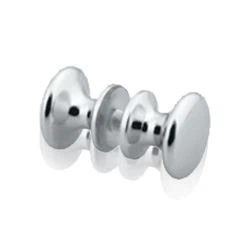Hey there! As a supplier of Stainless Steel Butt Hinges, I often get asked about the bending strength of these nifty little hardware pieces. So, I thought I'd dive deep into this topic and share some insights with you.
What is Bending Strength Anyway?
Let's start with the basics. Bending strength, in simple terms, is the ability of a material to withstand bending forces without breaking or deforming permanently. When it comes to stainless steel butt hinges, this is a crucial factor. You see, these hinges are used in all sorts of applications, from cabinets and doors to furniture. And in each of these applications, they need to be able to handle the stress of repeated opening and closing without giving up the ghost.


Factors Affecting the Bending Strength of Stainless Steel Butt Hinges
Material Grade
The type of stainless steel used in the hinge plays a huge role in its bending strength. There are different grades of stainless steel, such as 304 and 316. Grade 304 is a common choice. It's affordable and offers good corrosion resistance. However, if you need a hinge that can withstand more harsh environments, like near the ocean where there's a lot of salt in the air, grade 316 might be a better option. Grade 316 has more molybdenum in it, which gives it enhanced corrosion resistance and generally a bit more strength too.
Hinge Thickness
Thicker hinges tend to have higher bending strength. A thicker leaf of the hinge can better resist the forces that try to bend it. When you're choosing a stainless steel butt hinge, you'll notice that there are different thickness options available. For light - duty applications, like a small cabinet door, a thinner hinge might be sufficient. But for heavy - duty doors, like those on a commercial building or a large storage unit, you'll want a thicker hinge.
Design and Construction
The way the hinge is designed also affects its bending strength. Some hinges have reinforced edges or additional support structures. For example, a hinge with a solid pin design is generally stronger than one with a loose - pin design. The solid pin provides more stability and can better distribute the forces when the hinge is in use.
Testing the Bending Strength
Manufacturers usually test the bending strength of their stainless steel butt hinges. They use special equipment to apply a controlled bending force to the hinge until it either deforms or breaks. The results of these tests are often expressed in terms of a maximum load capacity. This tells you how much weight the hinge can support without failing.
But it's important to note that real - world conditions can be different from laboratory tests. Factors like the installation method, the frequency of use, and the type of load (static or dynamic) can all affect how well the hinge performs in practice.
Applications and Bending Strength Requirements
Residential Use
In a home, stainless steel butt hinges are commonly used on cabinet doors, closet doors, and even some furniture pieces. For cabinet doors, the bending strength requirements are relatively low. A standard - grade, medium - thickness hinge will usually do the job just fine. You can find a wide variety of options for these applications, like the Stainless Steel Table Hinge. It's designed to be both functional and aesthetically pleasing for your home furniture.
Commercial Use
In commercial settings, the demands on the hinges are much higher. For example, in a restaurant kitchen, the cabinet doors are opened and closed constantly throughout the day. You'll need a hinge with high bending strength to ensure it doesn't wear out quickly. The Heavy Duty Stainless Steel Hinge is a great choice for such applications. It can handle the heavy use and still maintain its integrity.
Industrial Use
Industrial applications often involve heavy - duty machinery and large doors. Non - mortice hinges are sometimes used in these scenarios. The Non Mortice Stainless Steel Hinge is designed to be strong and durable, capable of withstanding the high - stress environments found in factories and warehouses.
Choosing the Right Hinge Based on Bending Strength
When you're in the market for a stainless steel butt hinge, you need to consider your specific needs. First, think about the weight of the door or object that the hinge will support. If it's a heavy door, you'll want a hinge with a high bending strength.
Next, consider the frequency of use. A door that's opened and closed a lot will require a more robust hinge. Also, think about the environment. If the hinge will be exposed to moisture, chemicals, or other corrosive substances, you'll need to choose a hinge made from a suitable grade of stainless steel.
Why Choose Our Stainless Steel Butt Hinges?
As a supplier, we take pride in offering high - quality stainless steel butt hinges. We source our materials from trusted suppliers and use advanced manufacturing techniques to ensure that our hinges have excellent bending strength.
Our hinges go through rigorous testing to meet or exceed industry standards. Whether you need a hinge for a small residential project or a large - scale commercial application, we have the right product for you.
Let's Talk Business
If you're in the market for stainless steel butt hinges, I'd love to have a chat with you. We can discuss your specific requirements, and I can help you choose the perfect hinge for your project. Whether it's about the bending strength, the design, or the price, I'm here to assist you. Don't hesitate to reach out and start the conversation. We're committed to providing you with the best products and service.
References
- "Metals Handbook: Properties and Selection: Stainless Steels, Tool Materials, and Special - Purpose Metals", ASM International
- Engineering textbooks on materials science and mechanical engineering



